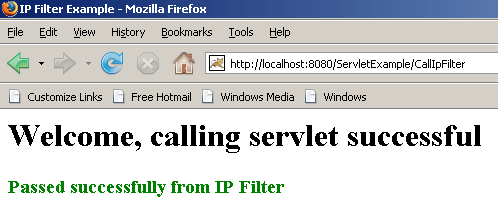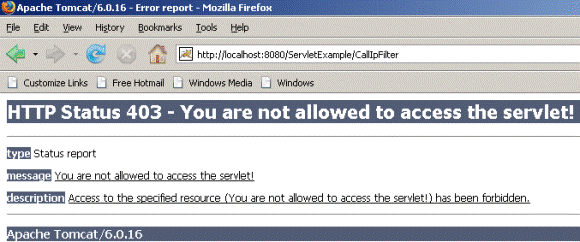IP Filter Example



The filter provides a basic security mechanism for a firewall to
determining what traffic passes through the firewall based on IP address
details. This protects the secure network from outsiders. A filter is an object that perform filtering tasks on request
and response. A FilterConfig
object used by a servlet container used to pass information to a filter during
initialization. Filters are registered in web.xml (deployment descriptor) of a web
application.
The most easiest
and effective way of minimize the risk from out side attacks is to filter
incoming requests based on the IP address of the client. For example, if you
have two web addresses that make requests using 192.168.10.146 and 127.0.0.1 and
wish to restrict the servlet requests only from 127.0.0.1 then following program
will help you.
Here is the Source Code of IPFilterExample.java
import java.io.*;
import java.util.*;
import javax.servlet.*;
import java.io.IOException;
import java.util.StringTokenizer;
import javax.servlet.Filter;
import javax.servlet.FilterChain;
import javax.servlet.FilterConfig;
import javax.servlet.ServletException;
import javax.servlet.ServletRequest;
import javax.servlet.ServletResponse;
import javax.servlet.http.HttpServletResponse;
public class IPFilterExample implements Filter{
public IPFilterExample() {}
public final static String IP = "193.168.10.146";
private FilterConfig filterConfig;
public void init(FilterConfig config) throws ServletException{
this.filterConfig = config;
}
public void doFilter(ServletRequest request, ServletResponse response,
FilterChain filterchain) throws IOException, ServletException {
response.setContentType("text/html");
PrintWriter out = response.getWriter();
out.println("<html><head><title>IP Filter Example</title></head>");
String userip = request.getRemoteAddr();
HttpServletResponse httpResponse = null;
if (response instanceof HttpServletResponse){
httpResponse = (HttpServletResponse) response;
}
if (IP.equals(userip)) {
httpResponse.sendError(HttpServletResponse.SC_FORBIDDEN,"You are
not allowed to access the servlet!");
} else {
filterchain.doFilter(request, response);
out.println("<body><h3><font color='green'>Passed successfully
from IP Filter<font></h3></body></html>");
}
}
public void destroy() {}
}
|
Here is the source code of CallIpFilter Servlet.
import java.io.*;
import javax.servlet.*;
import javax.servlet.http.*;
public class CallIpFilter extends HttpServlet{
public void doGet(HttpServletRequest request, HttpServletResponse
response)
throws ServletException,IOException{
response.setContentType("text/html");
PrintWriter pw = response.getWriter();
pw.println("<html>");
pw.println("<head><title>IP Filter Example</title></title>");
pw.println("<body>");
pw.println("<h1>Welcome, calling servlet successful</h1>");
pw.println("</body></html>");
}
}
|
Mapping of Filter (IPFilterExample) and Servlet
(CallIpFilter) in web.xml
<filter>
<filter-name>IPFilterExample</filter-name>
<filter-class>IPFilterExample</filter-class>
</filter>
<filter-mapping>
<filter-name>IPFilterExample</filter-name>
<url-pattern>/CallIpFilter</url-pattern>
</filter-mapping>
<servlet>
<servlet-name>CallIpFilter</servlet-name>
<servlet-class>CallIpFilter</servlet-class>
</servlet>
<servlet-mapping>
<servlet-name>CallIpFilter</servlet-name>
<url-pattern>/CallIpFilter</url-pattern>
</servlet-mapping> |
Running the servlet by this url: http://localhost:8080/ServletExample/CallIpFilter from
IP 193.168.10.146. The message will display as below:

But when, user access from IP address 127.0.0.1 then
he could not access the servlet (CallIpFilter) because IP Filter does not
allow to access for this IP address and status report will display as below:

Download Source Code





